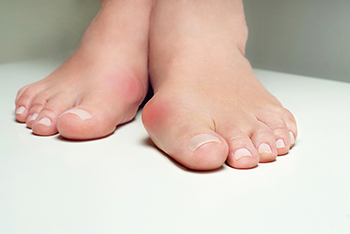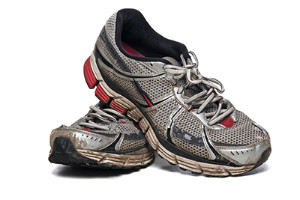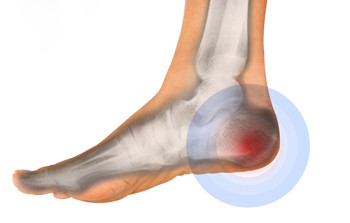Foot and Ankle Specialist
May 2022
Ankle Sprains, Strains, and Breaks

Injuries to your ankle such as sprains, strains, and breaks may feel similar, but are different. Sprains occur when there is an unnatural stretch or tear in the ligament(s) that support and bind the ankle. There may be an audible pop when you sprain your ankle, and there will be varying degrees of pain, bruising, swelling, and inflammation, and even a deformity, depending on the severity of the sprain. It may be difficult or even impossible to walk on the affected foot. Strains occur when tendons or muscles around the ankle are stretched or pulled repetitively or excessively. The symptoms of an ankle strain are similar, and may also include cramping and muscle spasms. Breaks are chips, fractures, or complete breaks in one or more of the bones in your ankle. Walking on a broken ankle may be impossible. Regardless of which injury has occurred, it is suggested that you see a podiatrist right away to be properly diagnosed and treated.
Ankle pain can have many different causes and the pain may potentially be serious. If you have ankle pain, consult with Don A. Shumway, DPM from Arizona. Our doctor will assess your condition and provide you with quality foot and ankle treatment.
Ankle pain is any condition that causes pain in the ankle. Due to the fact that the ankle consists of tendons, muscles, bones, and ligaments, ankle pain can come from a number of different conditions.
Causes
The most common causes of ankle pain include:
- Types of arthritis (rheumatoid, osteoarthritis, and gout)
- Ankle sprains
- Broken ankles
- Achilles tendinitis
- Achilles tendon rupture
- Stress fractures
- Tarsal tunnel syndrome
- Plantar fasciitis
Symptoms
Symptoms of ankle injury vary based upon the condition. Pain may include general pain and discomfort, swelling, aching, redness, bruising, burning or stabbing sensations, and/or loss of sensation.
Diagnosis
Due to the wide variety of potential causes of ankle pain, podiatrists will utilize a number of different methods to properly diagnose ankle pain. This can include asking for personal and family medical histories and of any recent injuries. Further diagnosis may include sensation tests, a physical examination, and potentially x-rays or other imaging tests.
Treatment
Just as the range of causes varies widely, so do treatments. Some more common treatments are rest, ice packs, keeping pressure off the foot, orthotics and braces, medication for inflammation and pain, and surgery.
If you have any questions, please feel free to contact our office located in Snowflake, AZ . We offer the newest diagnostic and treatment technologies for all your foot care needs.
Plantar Warts Can Be Treated!
Bunions and Other Lumps on the Foot

Probably the most commonly known lump on the foot is a bunion, but there are many other types, such as lumps, nodules, contusions, and cysts. They can be caused by infections, inflammation, tumors and trauma. The bunion, which is a bump on the side of the big toe, is the result of misplacement of the bones in the foot. A bunion often becomes a long term problem that in the worst cases calls for surgery to correct. Other lumps are the result of infections, insect bites, boils or trauma. Many lumps are temporary and others, such as ulcers brought on by systemic diseases, can develop into serious conditions. Rheumatoid arthritis can cause painful bumps to bloom around joints. A foot lump may be accompanied by other symptoms, including bleeding or bruising, swelling, redness and pain. If you notice an unusual lump on your foot, especially if it is painful, please consult a podiatrist who can offer a diagnosis and plan for treatment.
Everyday foot care is very important to prevent infection and other foot ailments. If you need your feet checked, contact Don A. Shumway, DPM from Arizona. Our doctor can provide the care you need to keep you pain-free and on your feet.
Everyday Foot Care
Often, people take care of their bodies, face and hair more so than they do for their feet. But the feet are a very important aspect of our bodies, and one that we should pay more attention to. Without our feet, we would not be able to perform most daily tasks.
It is best to check your feet regularly to make sure there are no new bruises or cuts that you may not have noticed before. For dry feet, moisturizer can easily be a remedy and can be applied as often as necessary to the affected areas. Wearing shoes that fit well can also help you maintain good foot health, as well as making it easier to walk and do daily activities without the stress or pain of ill-fitting shoes, high heels, or even flip flops. Wearing clean socks with closed shoes is important to ensure that sweat and bacteria do not accumulate within the shoe. Clean socks help to prevent Athlete’s foot, fungi problems, bad odors, and can absorb sweat.
If you have any questions please feel free to contact our office located in Snowflake, AZ . We offer the newest diagnostic and treatment technologies for all your foot and ankle needs.
Pointers on How to Buy Running Shoes

Many people who enjoy running know the importance of choosing the best running shoe for them. There are specific shoes that can help people to run faster, while adding comfort and possibly help to prevent injuries. The most important quality to look for in a running shoe is the fit. It is ideal to have a thumb’s width of space between the toe and the end of the shoe. This is beneficial in keeping the toes away from the top of the shoe while running downhill. It is suggested that the mileage and speed that is desired be determined before running shoes are purchased. This may help to decide which shoe is best for you. Additionally, recognizing existing foot conditions that can include flat feet or over-pronation is a key factor in choosing a correct running shoe. Many people buy their running shoes late in the day or in the evening when the feet are at their largest. It is best if running shoes are tried on and purchased based on how they feel, and not necessarily what they look like. If you would like more information about how to choose running shoes that fit well, please consult with a podiatrist.
If you are a runner, wearing the right running shoe is essential. For more information, contact Don A. Shumway, DPM from Arizona. Our doctor can provide the care you need to keep you pain-free and on your feet.
Choosing the Right Running Shoe for Your Foot Type
To increase performance and avoid the risk of injury, it is important to choose the right running shoe based on your foot type. The general design of running shoes revolves around pronation, which is how the ankle rolls from outside to inside when the foot strikes the ground.
- Neutral runners are able to choose from a wide variety of shoes, including minimalist shoes or even going barefoot.
- Runners who overpronate, or experience an over-abundance of ankle rolling, should choose shoes that provide extra motion control and stability.
- Runners who underpronate, or supinate, have feet that have high arches and lack flexibility, preventing shock absorption. They require shoes with more flexibility and cushion.
If you have any questions please feel free to contact our office located in Snowflake, AZ . We offer the newest diagnostic and treatment technologies for all your foot and ankle needs.
Children Can Experience Heel Pain Too

It may be difficult for you to know if your child is having heel pain because it is not often associated with children. However, certain conditions that cause heel pain can afflict the young, even if they do not know how to properly communicate their distress. Sever’s disease, for instance, is a form of heel pain that stems from irritation to the growth plate in the heels of growing children. Children can also develop plantar fasciitis from overuse of the heel or wearing shoes that do not fit. This condition is a painful inflammation of the plantar fascia tissue that connects to the heel to the toes. Active children can also develop tiny stress fractures of the heel bone which can occur gradually over time and be quite painful. There are certain clues your child’s condition may provide if you know what to look for. If your child limps or changes the way they walk or run, cuts back on physical activities, complains that their feet or heels feel odd or stiff, or that something is stuck in their shoe, they may have a painful heel condition. It is suggested that you make an appointment for your child with a podiatrist to have your child’s condition diagnosed and treated properly.
The health of a child’s feet is vital to their overall well-being. If you have any questions regarding foot health, contact Don A. Shumway, DPM of Arizona. Our doctor can provide the care you need to keep you pain-free and on your feet.
Tips for Keeping Children's Feet Healthy
- Make sure their shoes fit properly
- Look for any signs of in-toeing or out-toeing
- Check to see if they have Clubfoot (condition that affects your child’s foot and ankle, twisting the heel and toes inward) which is one of the most common nonmajor birth defects.
- Lightly cover your baby’s feet (Tight covers may keep your baby from moving their feet freely, and could prevent normal development)
- Allow your toddler to go shoeless (Shoes can be restricting for a young child’s foot)
- Cut toenails straight across to avoid ingrown toenails
- Keep your child’s foot clean and dry
- Cover cuts and scrapes. Wash any scratches with soap and water and cover them with a bandage until they’ve healed.
If you have any questions, please feel free to contact our office located in Snowflake, AZ . We offer the newest diagnostic and treatment technologies for all your foot care needs.
Facts About Arthritis

Arthritis has long been considered an ailment of the elderly, but a variety of other people are actually experiencing some form of arthritis, even children. Arthritis is an inflammation of the joints that produces pain, swelling, and muscle stiffness that often affect the toes, feet, and ankles. Among the causes are the deterioration of cartilage that then endangers the bones, an attack of the autoimmune system, smoking, previous injury, over-exercising or repetitive stress, serious infections, and heredity. There are many types of arthritis, including rheumatoid, psoriatic, osteoarthritis, fibromyalgia, gout, ankylosing spondylitis, lupus and juvenile. The most easily recognizable symptoms of arthritis include pain and swelling in the joints, redness, difficulty in walking or moving the joints, stiffness in the morning, and tenderness to the touch. Many treatments are available that allow you to live with this condition. If you think you or your child may have arthritis, it is a good idea to contact a podiatrist for a complete examination and diagnosis, as well as possible treatment plans.
Arthritis can be a difficult condition to live with. If you are seeking treatment, contact Don A. Shumway, DPM from Arizona. Our doctor can provide the care you need to keep you pain-free and on your feet.
Arthritic Foot Care
Arthritis is a term that is commonly used to describe joint pain. The condition itself can occur to anyone of any age, race, or gender, and there are over 100 types of it. Nevertheless, arthritis is more commonly found in women compared to men, and it is also more prevalent in those who are overweight. The causes of arthritis vary depending on which type of arthritis you have. Osteoarthritis for example, is often caused by injury, while rheumatoid arthritis is caused by a misdirected immune system.
Symptoms
- Swelling
- Pain
- Stiffness
- Decreased Range of Motion
Arthritic symptoms range in severity, and they may come and go. Some symptoms stay the same for several years but could potentially get worse with time. Severe cases of arthritis can prevent its sufferers from performing daily activities and make walking difficult.
Risk Factors
- Occupation – Occupations requiring repetitive knee movements have been linked to osteoarthritis
- Obesity – Excess weight can contribute to osteoarthritis development
- Infection – Microbial agents can infect the joints and trigger arthritis
- Joint Injuries – Damage to joints may lead to osteoarthritis
- Age – Risk increases with age
- Gender –Most types are more common in women
- Genetics – Arthritis can be hereditary
If you suspect your arthritis is affecting your feet, it is crucial that you see a podiatrist immediately. Your doctor will be able to address your specific case and help you decide which treatment method is best for you.
If you have any questions, please feel free to contact our office located in Snowflake, AZ . We offer the newest diagnostic and treatment technologies for all your foot care needs.







